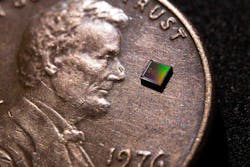A low-power temperature sensor currently under development at the University of San Diego might lead to sleeker temperature-sensing devices and designs used in wearables, diagnostic sensors for the industrial Internet of Things, and healthcare. The sensors would eliminate the need for bulky power supplies like batteries, and last years without having to be recharged.
The technology, still in its research phase, takes advantage of a phenomenon called the quantum tunneling effect, which allows very small quantities of electrons to leak through potential barriers in ultra-thin transistors. Though very small, this leakage current is enough to charge two capacitors at reference and temperature-dependent rates, as enabled by the one transistor's temperature-dependent intrinsic properties. It uses two gate-leakage metal-oxide semiconductor transistors (MOSFETs).
One tradeoff of the low-power design is the relatively low response time of up to 1 temperature reading per second. The team is still developing their technology to address its limitations, but for now, it stands out as pretty impressive. Pictured above, it was integrated onto a very small silicon chip no larger than 0.15 square millimeters.
A further explanation of the research can be read in the paper, “Near-Zero-Power Temperature Sensing via Tunneling Channels Through Complementary Metal-Oxide-Semiconductor Transistors” by Hui Wang and Patrick P. Mercier, published in the journal, Nature.
About the Author
Leah Scully
Associate Content Producer
Leah Scully is a graduate of The College of New Jersey. She has a BS degree in Biomedical Engineering with a mechanical specialization. Leah is responsible for Machine Design’s news items that cover industry trends, research, and applied science and engineering, along with product galleries. Visit her on Facebook, or view her profile on LinkedIn.
